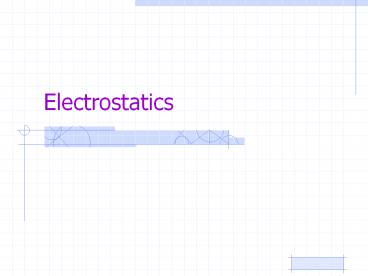Electrostatics - PowerPoint PPT Presentation
Title:
Electrostatics
Description:
Title: Van de Graff Generator Author: Charlie Last modified by: wcsd Created Date: 2/3/2005 1:52:30 AM Document presentation format: On-screen Show – PowerPoint PPT presentation
Number of Views:58
Avg rating:3.0/5.0
Title: Electrostatics
1
Electrostatics
2
Electrostatics
- Electrostatics is the study of electrical charges
at rest i.e., charged objects that are
stationary or in a fixed position.
3
Charged and Uncharged Objects
- Charged Object An object with an excess or
deficiency of electrons. - Neutral Object An object that has neither an
excess or deficiency of electrons.
- of electrons of protons
4
Types of Charge
- Positively charged objects have a deficiency of
electrons. - Negatively charged objects have a surplus of
electrons. - Note that the type of charge is in reference to
electrons and not protons. - Why?
- Because electrons exist outside the positive
nucleus and can be readily transferred from one
object to another.
5
Elementary Charge (e)
- What is the charge of an electron?
- -1.6 x 10-19 Coulombs (C)
- What is the charge of a proton?
- 1.6 x 10-19 Coulombs (C)
- The magnitude of the charge of the electron is
equal and opposite that of the proton. - Note In physics, the charge of an electron is
not 1 or 1!
6
Rubber and Wool/Glass and Silk
- Rubbing a rubber rod with a piece of wool The
rod will pull the electrons off the wool, so that
the rubber rod will end up with a net negative
charge and the wool will have a net positive
charge. - Rubbing a glass rod with a piece of silk The
silk will pull the electrons off the glass, so
that the glass rod will end up with a net
positive charge and the silk will have a net
negative charge.
7
Forces of Attraction and Repulsion
- In nature there are three principle forces
gravity, electromagnetic and nuclear (strong
weak). - Electromagnetic
- Attractive Forces Opposite charges attract one
another. A positively charged object will be
attracted to a negatively charged object and vice
versa. - Repulsive Forces Like charges repel. Two
positively charged objects or two negatively
charged objects in proximity to one another will
experience a repulsive force.
8
Separation of Charge
- When two neutral bodies are rubbed together, they
can become charged. - One body will become positively charged while the
other body will become negatively charged. - When a charged body is brought in close proximity
to one that is neutral, the neutral one will
develop an imbalance in charge distribution.
9
Separation of Charge and Lightning
Lightning
Lightning
10
Conservation of Charge
- How does the total charge of the system change?
- It doesnt. CONSERVATION OF CHARGE says that the
total charge of a system is conserved and that it
can never be created nor destroyed.
11
Example 1
- Two charge spheres are brought into contact with
one another and then separated. One of the
spheres has a charge of -5 C while the other has
a charge of 8 C prior to them being brought into
contact with one another. What is the charge on
both of the spheres afterwards, and how many
electrons exist on each sphere.
12
Example 1, cont.
- Applying the law of conservation of charge, the
total charge of the system of charges must remain
constant. - 8 C -5 C 3 C
- Since there are only two spheres, the charge will
be equally distributed over the surface of the
two spheres. Consequently, each sphere will have
1.5 C of charge.
_
_
_
_
_
_
_
_
_
_
_
_
_
_
_
13
Conductors and Insulators
- Conductors Materials that allow for the free
flow of electrons. - The best conductors come from the transitional
elements of the periodic table. - The characteristics of the d orbitals permit
electrons to flow freely because at least one
electron is not held tightly by the nucleus. - Insulators Materials that do not allow electrons
to flow freely.
14
Charge Distribution
- Conductors Excess charges will maximize the
space between them, which means that they will
reside on the surface of the object with a
uniform distribution. - Insulators Excess charges will be located
largely where they were transferred to the
material.
15
Charge Distribution
- One of these isolated charged spheres is copper
and the other is rubber. The diagram below
depicts the distribution of - charge over the
surface of two spheres. Which one is rubber and
which one is copper?
16
Charge by Conduction
- Electrons flow from a charged object to an
uncharged object through contact.
17
Charge by Induction
- Electrons flow from one sphere to the other due
to separation of charge.
18
Charge by Induction of an Electroscope
19
Key Ideas
- Objects become charged by losing or gaining
electrons. - Negatively charged objects have an excess of
electrons. - Positively charged objects have a deficiency of
electrons. - Like charges repel.
- Unlike charges attract.
- Conductors allow electrons to flow freely.
- Insulators do not allow electrons to flow easily.
- Separation of charge occurs when objects become
charged or when a charged object is brought in
local proximity to an uncharged (neutral) object.
20
Key Ideas
- Charge by conduction results when charge is
transferred through contact. - Charge by induction occurs when a charged object
is place in local proximity to a neutral object
causing a separation of charge.































